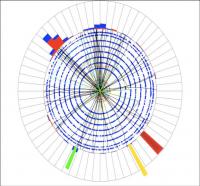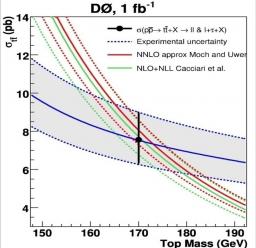Until the advent of the LHC, the Tevatron at the Fermi National Accelerator Laboratory, Fermilab (close to Chicago, USA), will remain the world's most powerful collider and the only location where the top1 quark can be produced.
The DØ experiment recently published2 results on the measurement of the rate of production of top-antitop quark pairs. This quantity, which is dependent on the value taken for the mass of the top quark, enables a prediction to be made for that mass using the standard model3. The top quark, which was discovered at Fermilab in 1995, remains the subject of very active research. Methods of analysis and the quantity of data are forever improving, which is resulting in subsequent improvements in the accuracy of the measurement of the top quark mass. The precise measurement of this value, combined with results from other precision measurements, enables the most probable mass of the Higgs Boson to be estimated. Hence improved measurements of the mass of the top quark is tightening the vice in the search for the Higgs boson.
The top quark is the most massive of the six quarks which are known to us. Its large mass, comparable to that of a gold atom, gives it a special characteristic among the family of quarks: There is no linked state (or particle) with a top quark (or antitop). The characteristics of this quark are measured by detecting its decay products. Top is produced in top-antitop pairs. The top quark decays to form a W boson and a beauty quark which in turn produces a jet4 of particles. The W boson has two decay possibilities, and a clean channel is that where at least one W decays to give a lepton5 and a neutrino. The characteristics of the production of a top-antitop pair are an event with two leptons (hence this channel is referred to as dileptonic), two jets coming from the beauty quarks and the missing energy due to the neutrinos which escape from the detector without interacting. One such event in the D0 detector is illustrated in figure 1.

Decay ofthe top quark top via the dileptonic channel.
The collision in the outer ring, symbolised in green, represents the muon, the collision in red represents an electron, the two jets coming from the b and anti-b quarks are the blue and red clusters and the impact in yellow represents the missing energy of the two, undetected, neutrinos
The DØ team at SPP6 have measured the rate of top-antitop pair production on the dileptonic channel with a set of data corresponding to all of the statistics from the first phase of Run II (which began in 2001) on the Tevatron, with more than 1.5 billion events. Measurement of this effective cross-section requires knowledge of the efficiency of top-antitop pair detection which itself depends on the mass of the top quark. The dependence of this measurement as a function of the top mass is illustrated in figure 2 (solid blue curve flanked by two broken curves in blue representing the measurement uncertainty). This rate of experimental production can be compared with that calculated by the standard model for the various values of the mass of the top quark (red and green curves corresponding to two calculations, the predictions in red being those which encompass the most theoretical considerations).

Rate of production of top-antitop pairs via the dileptonic channel as a function of top quark mass. The blue curves correspond to measurements and the red and green curves represent theory.
Firstly, we can see that the measurement of the pair production rate is in good agreement with the predictions of the standard model, which is reassuring... It enables us to now perform an indirect measurement of the mass of the top quark by comparing the blue and red curves. The DØ team at SPP6 found a value of 173.3 +9,9-8,6 GeV (the error margins are not symmetric because the errors arising from the theoretical predictions are themselves not symmetric , cf. the dotted red curves).
This new result is in clear agreement with the direct measurement of the mass of the top quark, based on comparison of the experimental and simulated distributions7.
By combining all the disintegration routes for the top-antitop pairs from the two DØ and CDF experiments of the Tevatron, a value of 173.1 ± 1.3 GeV was obtained (cf figure 3).
Although less precise, the indirect measurement is not less complementary because of the top quark mass, a parameter requiring two analyses, acts with various degrees of significance, and this significance is less in the case of the indirect measurement. Finding agreement between these two analyses is a significant result.
The programme to collect high luminosity data from Tevatron run IIB, started in 2006 and should be able to continue, with greater accuracy, the direct and indirect measurements of the mass of the top quark, in particular on the dileptonic channels.
The DØ team from SPP is engaged in two types of analysis. One, on the components of the direct measurement, which relies on the first data from run IIB, was the subject of a thesis at SPP which was submitted in 2008 and of several presentations at international conferences in 2008. Moreover the results of this analysis have been taken into account in the new combination. A measurement with all of the data from run IIB (by 2010) is planned and will also be the subject of a thesis in due course, as will the new indirect measurement, presented here.
1) The top quark is the most massive of the 6 quarks discovered to date.
2) Physical Letters B
3) Theoretical framework which describes matter as being made up from elementary particles
4) Experimental signature of the presence of quark products during a hard process
5) An electron or one of its twin brothers more massive than the muon or tau.
6) Particle Physics Service
5) An electron or one of its twin brothers more massive than the muon or tau.
7) Simulation including the detector response and the physics of the standard model. Hence it has the mass of the top quark as a parameter
Press contacts:
Marc BESANCON (SPP)
• The ultimate constituents of matter › Particle physics at colliders
• Institute of Research into the Fundamental Laws of the Universe • The Electronics, Detectors and Computing Division • The Particle Physics Division
• D0
